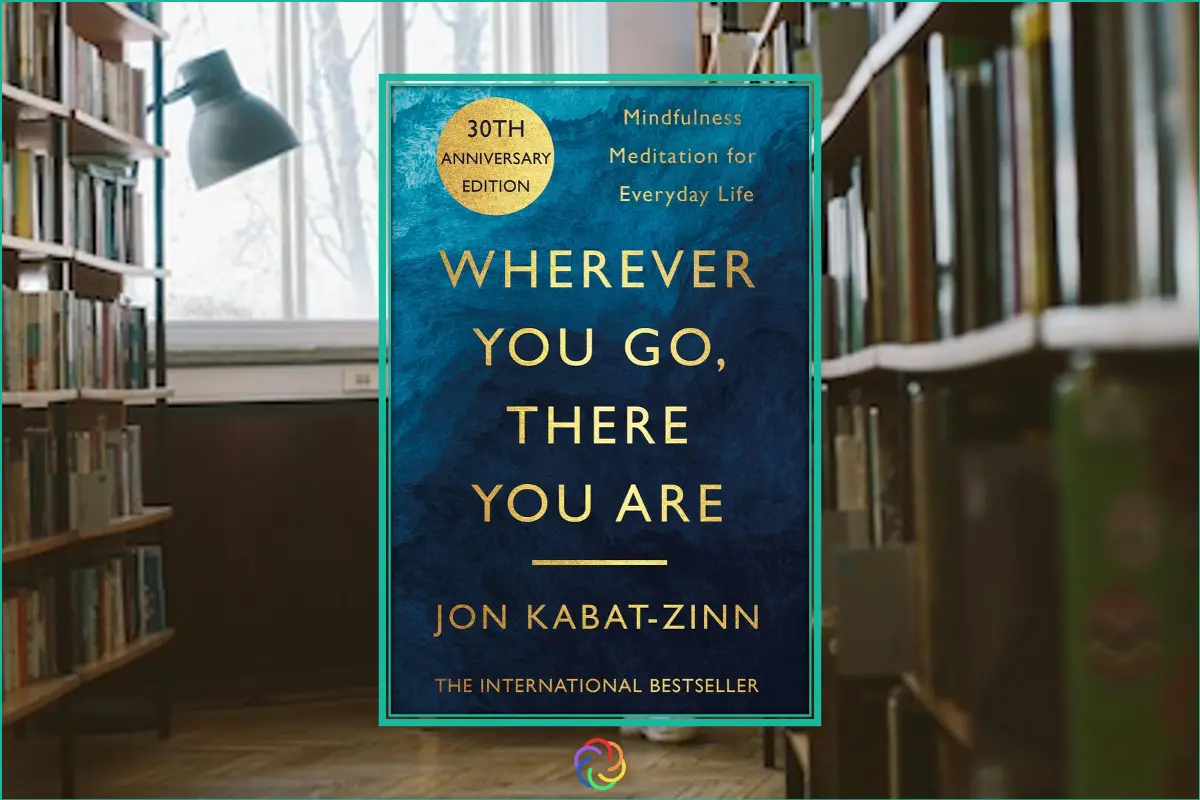Wherever You Go, There You Are: A Mindful Journey to the Present Moment
Jon Kabat-Zinn’s seminal work Wherever You Go, There You Are offers readers a comprehensive guide to incorporating mindfulness into everyday life. This expanded analysis delves deeper into the book’s wisdom and practical applications, revealing why this work continues to resonate with millions worldwide nearly three decades after its publication.
Introduction: About the Book and Author
Wherever You Go, There You Are: Mindfulness Meditation in Everyday Life (1994) is a transformative book by Dr. Jon Kabat-Zinn, a pioneering scientist and meditation teacher who founded the Stress Reduction Clinic at the University of Massachusetts Medical School. He is best known for developing Mindfulness-Based Stress Reduction (MBSR), a clinically validated program that has helped millions manage stress, chronic pain, and anxiety.
This book is a practical, accessible guide to mindfulness-free from religious dogma, yet deeply rooted in scientific research. Kabat-Zinn presents meditation not as an esoteric ritual but as a simple, daily practice for cultivating presence and clarity. As he emphasizes,
a more than 2000-year-old Buddhist method of living fully in the present, observing ourselves, our feeling, others and our surroundings without judging them.
The book’s enduring appeal stems from its ability to present these ancient techniques in a contemporary, secular framework appropriate for modern life.
Kabat-Zinn deliberately avoids trendiness, presenting
meditation as a natural activity that can be practiced anytime and anywhere, without props or trappings.
This approach has made the book accessible to countless readers who might otherwise have dismissed meditation as too esoteric or spiritual for their practical needs.
Reception, Awards, and Recommendations
A New York Times bestseller, the book has been widely praised for its clarity and real-world applicability. Notable endorsements include Oprah Winfrey, Daniel Goleman, and Harvard Medical School. While some critics argue the book lacks philosophical depth, most readers appreciate its grounded, approachable style-making mindfulness attainable for everyone. The book’s influence extends across multiple platforms, with discussions and recommendations appearing on social media and in various mindfulness communities.
Summary of Wherever You Go, There You Are
Part 1: The Foundations of Mindfulness
Kabat-Zinn opens with a deceptively simple definition of mindfulness:
Mindfulness means paying attention in a particular way: on purpose, in the present moment, and nonjudgmentally.
He dispels common myths, meditation isn’t about emptying the mind or achieving bliss, but about observing life as it unfolds. The book emphasizes that mindfulness is not about achieving a specific outcome but rather about being fully present and aware in each moment of our lives.
Key Concepts & Practices:
“Doing” vs. “Being” Mode
- Modern life traps us in “doing” mode-constantly planning, reacting, and striving.
- Mindfulness invites us into “being” mode, resting in awareness without agenda.
- Example: Instead of rushing through a meal, savor each bite, noticing flavors and textures.
Kabat-Zinn cautions against avoiding life’s messiness for the allure of tranquility:
You might be tempted to avoid the messiness of daily living for the tranquility of stillness and peacefulness. This of course would be an attachment to stillness, and like any strong attachment, it leads to delusion.
The Breath as an Anchor
- The breath is an always-accessible anchor to the present.
- Exercise: Spend 5 minutes observing your breath. When your mind wanders (as it will), gently return focus-without self-criticism.
If you have the time to breathe, you have the time to meditate.
Non-Striving
- Unlike goal-driven tasks, mindfulness has no “end goal.”
You can’t stop the waves, but you can learn to surf.
This approach allows for accepting life’s challenges without being overwhelmed by them.
Part 2: Cultivating Mindfulness in Daily Life
Kabat-Zinn emphasizes that formal meditation is just the start-the real practice is weaving mindfulness into ordinary moments. He illustrates this through various practical examples and chapters such as “Cleaning the Stove While Listening to Bobby McFerrin” and “Cat Food Lessons”, demonstrating how even mundane activities can become opportunities for presence.
Key Practices:
Walking Meditation
- Walk not to reach a destination, but to fully experience walking.
- Notice the lift and fall of each foot, the air on your skin.
- Kabat-Zinn explains how concentrating on walking or standing can become profound meditation practices.
Loving-Kindness Meditation (Metta)
- Cultivate compassion by silently offering phrases like: “May I be happy. May you be safe. May all beings be free from suffering.”
The Body Scan
- A cornerstone of MBSR, this practice involves systematically noticing sensations in each body part.
Visualization Practices
- Kabat-Zinn teaches readers various visualization techniques, including visualizing mountains and lakes, which serve as powerful metaphors for stability and reflection in meditation practice.
Part 3: Deepening the Practice
Kabat-Zinn addresses common challenges:
Dealing with Distractions
- Wandering thoughts are inevitable. The practice is in returning, not in perfect focus.
Thoughts are like clouds-observe them drifting by without chasing them.
We take the moments from our days, and string them into years. And all too often, they seem colorless and without flavor. It is when we pay attention that the knot of boredom is cut.
Mindfulness in Difficult Emotions
- Instead of resisting anger or sadness, lean into them with curiosity.
What you resist persists. What you befriend, you begin to understand.
As long as you are breathing, there is more right with you than wrong with you, no matter how ill or how hopeless you may feel.
The Illusion of Time
- We often live “lost in thought”-rehashing the past or worrying about the future.
- Exercise: Pause hourly to ask, “What is happening right now?”
Mindful Transitions
- In a chapter titled “Going Upstairs,” Kabat-Zinn tries to catch himself when he is hurrying between the levels of his house, to get something or talk to someone. This demonstrates how even brief moments of transition can become opportunities for practice.
Parenting as Meditation
- The book includes two chapters on parenting as a form of meditation (children as “live-in Zen masters”), showing how children can be our greatest teachers of presence and patience.
Part 4: The Ripple Effects of Mindfulness
Kabat-Zinn explores how mindfulness transforms relationships, work, and society. One profound question he poses is:
What Is My Job on the Planet with a Capital J?
This invites readers to contemplate their deeper purpose beyond career titles or roles.
Final Wisdom:
The little things? The little moments? They aren’t little.
This quote encapsulates Kabat-Zinn’s emphasis on the profound significance of ordinary moments when met with full awareness.
Criticism & Counterpoints
Some critiques:
- Lacks philosophical depth compared to traditional Buddhist texts.
- Repetitive exercises may frustrate advanced practitioners.
Yet, its simplicity is its strength-demystifying mindfulness for beginners. The book is free of trendiness and presents meditation as a natural human capacity rather than an exotic practice.
Key Takeaways from the Book
What Is Meditation?
Meditation is simply about being yourself and knowing something about who that is.
It’s not about escaping life but waking up to it-recognizing that every moment shapes your path. He further explains that healing and transformation of the mind are not metaphysical or esoteric practices but actual things that can happen in real time with real effort and commitment.
The Power of Non-Judgmental Awareness
Mindfulness teaches us to:
- See thoughts as thoughts-not absolute truths.
- Separate events from the stories we tell about them.
- Example: If you feel anxious, instead of thinking “I’m falling apart,” observe: “There’s tension in my chest. Interesting.”
This approach parallels the story of the butcher in Kabat-Zinn’s book, who explains:
My whole being apprehends. My senses are idle. The spirit free to work without plan follows its own instinct.
This illustrates how deep mindfulness leads to a state where action flows naturally without forced effort.
Loving-Kindness in Action
The book guides readers to practice Metta, even toward difficult people:
Forgive them for their limitations, remembering Yeats’s line: ‘Why, what could she have done, being what she is?’
Kabat-Zinn also notes:
Sometimes your joy is the source of your smile, but sometimes your smile can be the source of your joy.
This highlights how our actions can create our inner states rather than merely reflecting them.
Life as a Mountain Climb
Kabat-Zinn’s metaphor reminds us:
The challenges we face are the very opportunities we need to grow.
He reinforces this with:
You have problems. We all do. But once we learn to be present in each moment, the problems cease to define us and can be managed more effectively.
Final Thoughts: Why This Book Matters
Wherever You Go, There You Are is more than a book-it’s a toolkit for living. Whether you’re new to mindfulness or a seasoned practitioner, Kabat-Zinn’s teachings offer practical wisdom for a calmer, more intentional life. The book speaks to the universal human condition while providing concrete practices that help readers navigate the complexities of modern existence.
The Key Lesson: True transformation begins not by chasing the future, but by fully inhabiting the present. As Kabat-Zinn beautifully puts it,
If we are not careful, it is all too easy to fall into becoming more of a human doing than a human being.
In a world increasingly defined by distraction and speed, this invitation to presence remains as vital today as when first published.




MindfulCircles
Icebreaker questions:
– What’s one childhood habit or ritual (a walk in nature, family meals, doodling…) that—looking back—was really a form of mindfulness?
– Share a moment from your past when you caught yourself on ‘autopilot’—and what you wish you’d noticed instead.